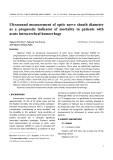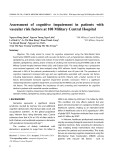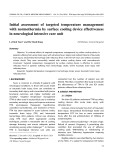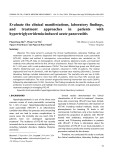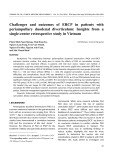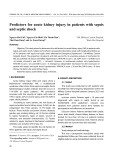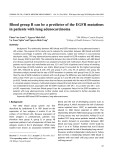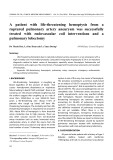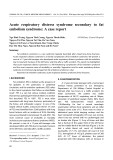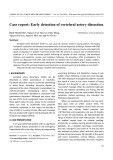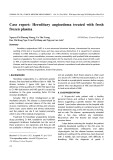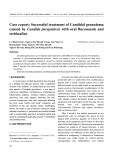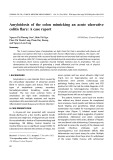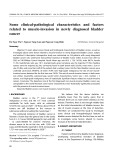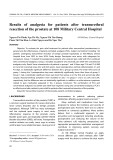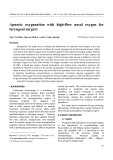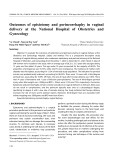
HUE JOURNAL OF MEDICINE AND PHARMACY ISSN 3030-4318; eISSN: 3030-4326HUE JOURNAL OF MEDICINE AND PHARMACY ISSN 3030-4318; eISSN: 3030-4326
92 93
Hue Journal of Medicine and Pharmacy, Volume 15, No.2/2025 Hue Journal of Medicine and Pharmacy, Volume 15, No.2/2025
Comparative analysis of antibiotic resistance patterns and virulence
genes in Staphylococcus aureus strains isolated from clinical samples
at Hue University of Medicine and Pharmacy Hospital
Ung Thi Thuy, Nguyen Thi Khanh Linh, Dinh Thi Hai, Hoang Thi Minh Ngoc, Nguyen Hoang Bach*
Department of Microbiology - University of Medicine and Pharmacy, Hue University
Abstract
Introduction: Staphylococcus aureus (S. aureus) is a common pathogen associated with severe infections,
and its antibiotic resistance is potentially associated with various virulence factors. This study explored the
relationship between antibiotic resistance and virulence genes in S. aureus isolates from the clinical samples
of Hue University of Medicine and Pharmacy Hospital. Materials and Methods: Between 2021 and 2022, 122
S. aureus strains were isolated from clinical samples, with 114 non-duplicate strains undergoing antibiogram
and virulence gene analysis. The antimicrobial susceptibility was tested using the Kirby-Bauer method.
Molecular genotyping of Nuc, mecA, spa, pvl, and tsst-1 was performed using singleplex and multiplex
PCR techniques. Results: Out of 122 isolated S. aureus strains, 114 non-duplicate strains were analyzed,
with MRSA (Methicillin-resistant Staphylococcus aureus) comprising 49.1% and MSSA(Methicillin-sensitive
Staphylococcus aureus) 50.9%. Carriage of the mecA and spa genes was significantly associated with MRSA
infection (p<0.05). The mecA gene was associated with resistance to penicillin, erythromycin, clindamycin,
and tetracycline (p<0.05), whereas the spa gene was associated with oxacillin resistance (p=0.002). tsst-1 was
linked to resistance to penicillin and clindamycin (p<0.001). No correlation was found between the presence
of pvl gene and antibiotic resistance. Conclusion: The presence of methicillin-resistant genes in MSSA poses
significant challenges for its diagnosis and treatment. Investigating the virulence and antimicrobial resistance
of MRSA and MSSA is crucial to improving patient treatment outcomes in the future.
Keywords: Staphylococcus aureus, MRSA, MSSA, nuc, mecA, spa, pvl, tsst-1.
*Corresponding Author: Nguyen Hoang Bach, Email: nhbach@huemed-univ.edu.vn
Received: 8/11/2024; Accepted: 10/3/2025; Published: 28/4/2025
DOI: 10.34071/jmp.2025.2.14
1. INTRODUCTION
Staphylococcus aureus (S. aureus) has emerged
as one of the most common bacteria associated
with hospital- and community-acquired infections. It
is associated with various conditions, including skin
and soft tissue infections, osteomyelitis, invasive
infections, and septicemia [1]. Methicillin-resistant
Staphylococcus aureus (MRSA) strains are known
to have evolved through a combination of virulence
and methicillin-resistant genes, enabling them
to invade healthy individuals and spread quickly
within populations. Therefore, understanding
the molecular characteristics of MRSA isolates is
crucial for effective infection control. While most
studies have focused on MRSA, infections caused by
methicillin-sensitive Staphylococcus aureus (MSSA)
may be even more clinically significant, as MSSA
isolates often possess diverse virulence factors [2].
A previous study indicated that MSSA strains exhibit
similar patterns of enterotoxin distribution, the
methicillin-resistant gene mecA, and the virulence
gene tsst-1 (toxic shock syndrome toxin-1 gene) as
MRSA strains. Consequently, MSSA isolates should
be regarded as similar to MRSA strains because they
can serve as potential sources of infection [3].
S. aureus produces several virulence factors,
including toxins, enzymes, and adhesion factors,
contributing to its pathogenicity. The Panton-
Valentine leukocidin (PVL) toxin, encoded by the pvl
gene, is linked to infections ranging from skin and
soft tissue infections to severe conditions, such as
necrotizing pneumonia. Additionally, Toxic Shock
Syndrome Toxin-1 (TSST-1), encoded by tsst-1, can
cause life-threatening toxic shock syndrome (TSS),
such as rash, fever, and organ failure. Understanding
the prevalence of the tsst-1 gene and its link to
antibiotic resistance is crucial for improving patient
outcomes. Toxins from both the pvl and tsst-1 genes
can lead to severe infections, which are even more
challenging to treat when associated with the mecA
gene-mediated resistance to beta-lactam antibiotics
[4]. The advancement of molecular biological
techniques has been crucial for detecting genetic
patterns in MRSA and MSSA. For example, the nuc
gene is highly specific for identifying S. aureus, along
with the presence of virulence genes such as spa






